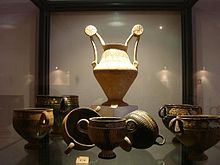
Back Месапи Bulgarian Mesapi BS Messapis Catalan Messapiové Czech Messapier Danish Messapier German Μεσσάπιοι Greek Mesapianoj Esperanto Mesapios Spanish Messapia Finnish

The Messapians were an Iapygian tribe who inhabited Salento in classical antiquity. Two other Iapygian tribes, the Peucetians and the Daunians, inhabited central and northern Apulia respectively. All three tribes spoke the Messapian language, but had developed separate archaeological cultures by the seventh century BC. The Messapians lived in the eponymous region Messapia, which extended from Leuca in the southeast to Kailia and Egnatia in the northwest, covering most of the Salento peninsula.[1] This region includes the Province of Lecce and parts of the provinces of Brindisi and Taranto today.
Starting in the third century BC, Greek and Roman writers distinguished the indigenous population of the Salento peninsula differently. According to Strabo, the names Iapygians, Daunians, Peucetians and Messapians were exclusively Greek and not used by the natives, who divided the Salento in two parts. The southern and Ionian part of the peninsula was the territory of the Salentinoi, ranging from Otranto to Leuca and from Leuca to Manduria. The northern part on the Adriatic belonged to the Kalabroi and extended from Otranto to Egnatia with its hinterland.[2]
After the conquest of the Salento by the Roman Republic in 266 BC[3] the distinction between the Iapygian tribes blurred as they were assimilated into ancient Roman society. Strabo makes it clear that in his time, the end of the first century BC, most people used the names Messapia, Iapygia, Calabria and Salentina interchangeably for the Salento.[4] The name Calabria for the entire peninsula was made official when the Roman emperor Augustus divided Italy in regions and gave the whole region of Apulia the name Regio II Apulia et Calabria.[5] Archaeology still follows the original Greek tripartite division of tribes based on the archaeological evidence.[6]
- ^ Carpenter, Lynch & Robinson 2014, p. 2, 18 and 38.
- ^ Carpenter, Lynch & Robinson 2014, p. 38–39.
- ^ Carpenter, Lynch & Robinson 2014, p. 46.
- ^ Strabo 1924, 6.3.5.
- ^ Colafemmina 2012, p. 1.
- ^ Carpenter, Lynch & Robinson 2014, p. 40.